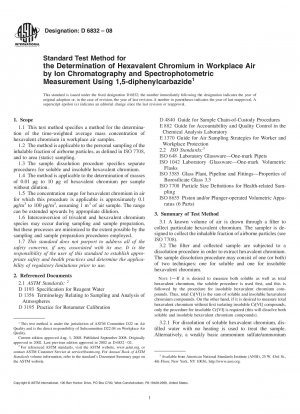ASTM D6832-08
Standard Test Method for the Determination of Hexavalent Chromium in Workplace Air by Ion Chromatography and Spectrophotometric Measurement Using 1,5-diphenylcarbazide
- Standard No.
- ASTM D6832-08
- Release Date
- 2008
- Published By
- American Society for Testing and Materials (ASTM)
- Status
- Replace By
- ASTM D6832-13
- Latest
- ASTM D6832-13(2018)
- Scope
Airborne hexavalent chromium is carcinogenic (1), and analytical methods for the measurement of this species in workplace aerosols are desired. Worker exposure to hexavalent chromium occurs primarily through inhalation (1), and this test method provides a means for exposure assessment to this highly toxic species. Analytical results from this procedure can be used for regulatory compliance purposes (2).
1.1 This test method specifies a method for the determination of the time-weighted average mass concentration of hexavalent chromium in workplace air samples.
1.2 The method is applicable to the personal sampling of the inhalable fraction of airborne particles, as defined in ISO 7708, and to area (static) sampling.
1.3 The sample dissolution procedure specifies separate procedures for soluble and insoluble hexavalent chromium.
1.4 The method is applicable to the determination of masses of 0.01 μg to 10 μg of hexavalent chromium per sample without dilution.
1.5 The concentration range for hexavalent chromium in air for which this procedure is applicable is approximately 0.1 μg/m3 to 100 μg/m3, assuming 1 m3 of air sample. The range can be extended upwards by appropriate dilution.
1.6 Interconversion of trivalent and hexavalent chromium species may occur during sampling and sample preparation, but these processes are minimized to the extent possible by the sampling and sample preparation procedures employed.
1.7 This standard does not purport to address all of the safety concerns, if any, associated with its use. It is the responsibility of the user of this standard to establish appropriate safety and health practices and determine the applicability of regulatory limitations prior to use.
ASTM D6832-08 Referenced Document
- ASTM D1193 Standard Specification for Reagent Water
- ASTM D1356 Standard Terminology Relating to Sampling and Analysis of Atmospheres*, 2024-04-19 Update
- ASTM D3195 Standard Practice for Rotameter Calibration
- ASTM D4840 Standard Guide for Sample Chain-of-Custody Procedures
- ASTM E1370 Standard Guide for Air Sampling Strategies for Worker and Workplace Protection
- ASTM E882 Standard Guide for Accountability and Quality Control in the Chemical Analysis Laboratory
- ISO 1042 Laboratory glassware - One-mark volumetric flasks
- ISO 3585 Borosilicate glass 3.3 - Properties
- ISO 648 Laboratory glassware - Single-volume pipettes
- ISO 7708 Air quality - Particle size fraction definitions for health-related sampling
- ISO 8655 Piston-operated volumetric apparatus — Part 9: Manually operated precision laboratory syringes
ASTM D6832-08 history
- 2018 ASTM D6832-13(2018) Standard Test Method for the Determination of Hexavalent Chromium in Workplace Air by Ion Chromatography and Spectrophotometric Measurement Using 1,5-diphenylcarbazide
- 2013 ASTM D6832-13e1 Standard Test Method for the Determination of Hexavalent Chromium in Workplace Air by Ion Chromatography and Spectrophotometric Measurement Using 1,5-diphenylcarbazide
- 2013 ASTM D6832-13 Standard Test Method for the Determination of Hexavalent Chromium in Workplace Air by Ion Chromatography and Spectrophotometric Measurement Using 1,5-diphenylcarbazide
- 2008 ASTM D6832-08 Standard Test Method for the Determination of Hexavalent Chromium in Workplace Air by Ion Chromatography and Spectrophotometric Measurement Using 1,5-diphenylcarbazide
- 2002 ASTM D6832-02 Standard Test Method for the Determination of Hexavalent Chromium in Workplace Air by Ion Chromatography and Spectrophotometric Measurement Using 1,5-diphenylcarbazide
